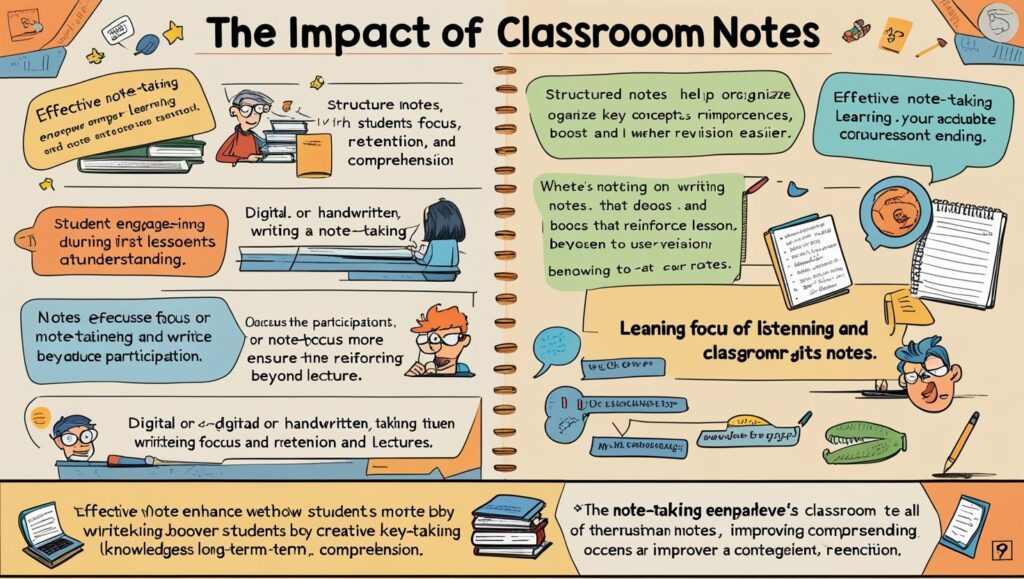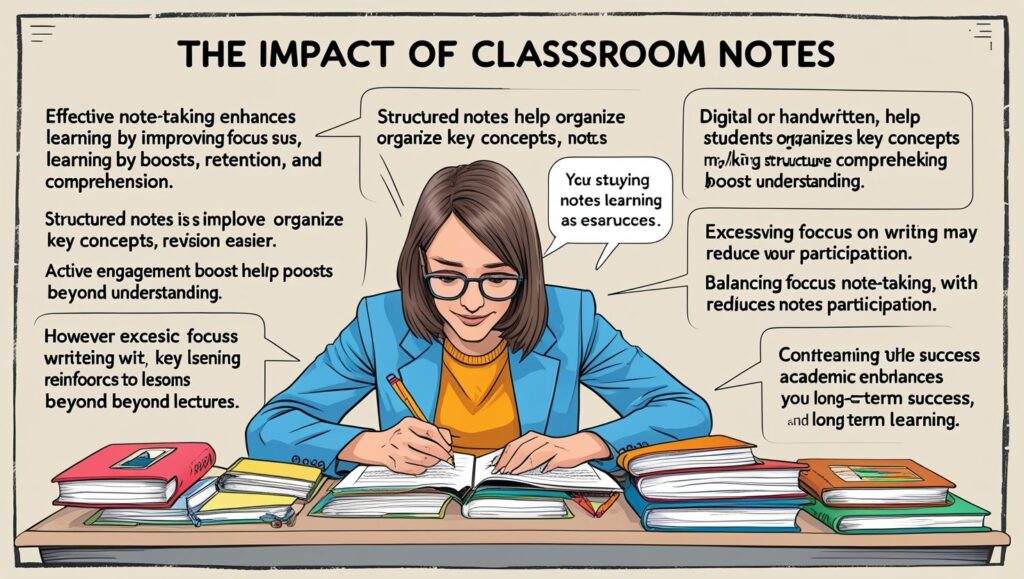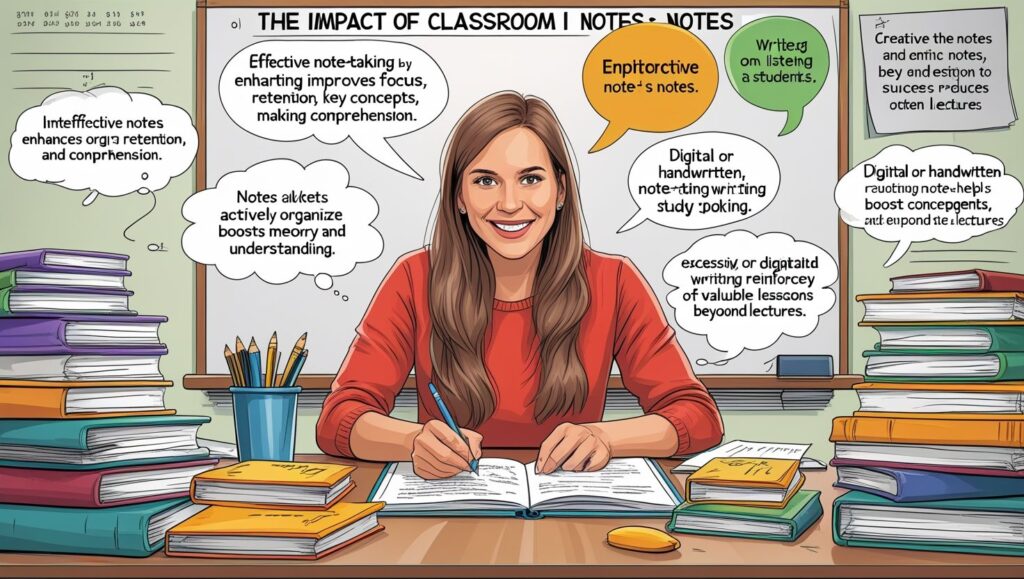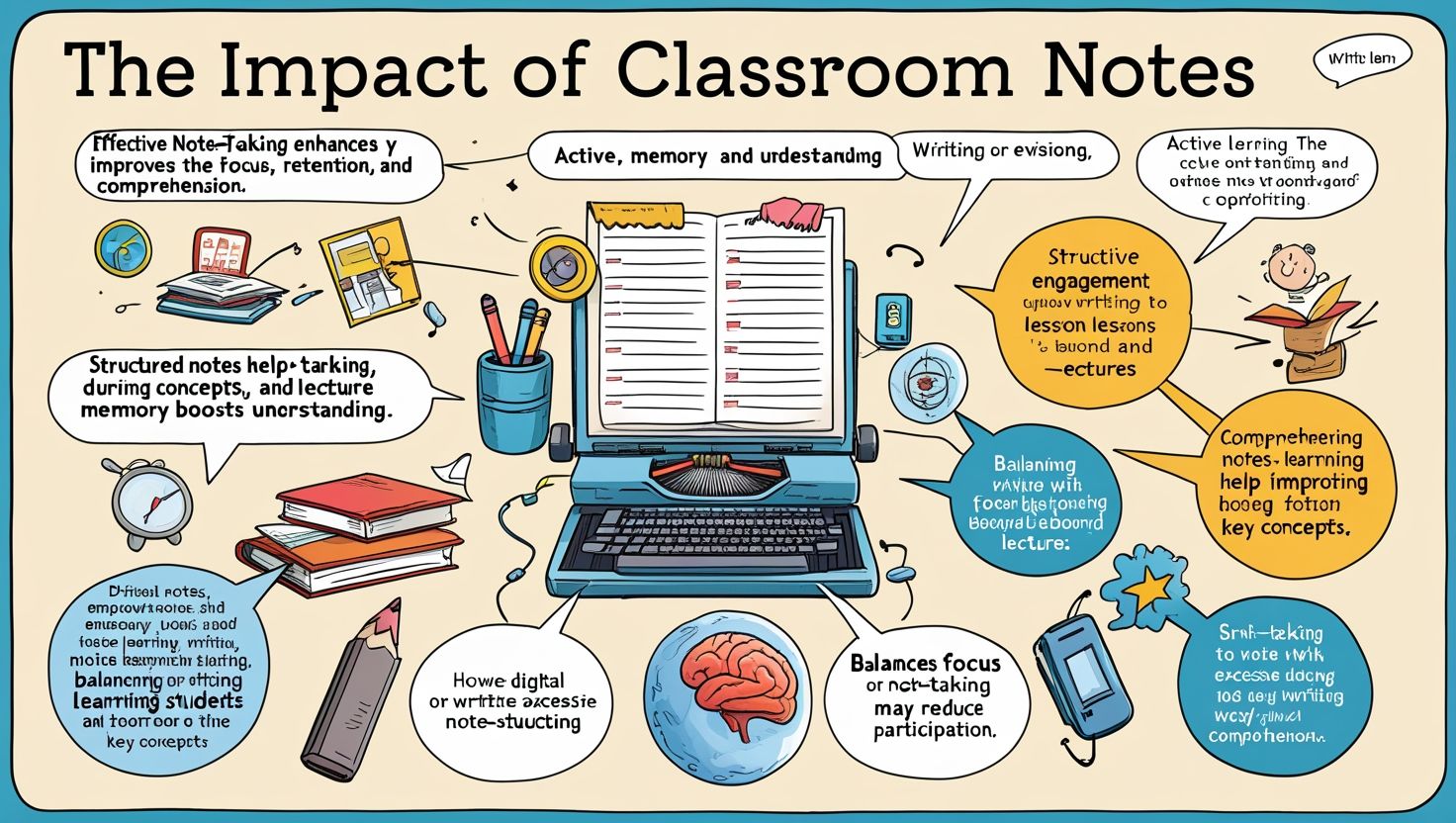Introduction
Classroom notes are a central part of the learning process. They act as a bridge between what is taught and what is remembered. Students use notes to capture key ideas, explanations, and examples from lessons. This process helps them retain and recall information later. In many ways, notes are more than just written records. They become personal learning tools tailored to the individual’s understanding.
Moreover, classroom notes promote active engagement during lectures. As students listen and write, they process information in real time. This dual action strengthens memory and comprehension. Without note-taking, many important points can be lost or misunderstood. Furthermore, notes provide a structured summary of the topic. They allow learners to revisit content long after the lesson ends. When organized well, they highlight essential ideas, making revision faster and more effective.
In addition, classroom notes improve focus. Students who write notes stay more alert and attentive. This prevents daydreaming and encourages participation. Teachers also benefit, as they can see what students understood from the lesson.
Therefore, the impact of classroom notes is significant. They influence comprehension, memory, study habits, and academic performance. In the following sections, we will explore their benefits, methods, and effects on different learning styles. Each aspect will show how valuable note-taking is for both students and educators.
Enhancing Memory Retention
One of the strongest impacts of classroom notes is their role in enhancing memory retention. Writing notes forces students to process information more deeply. This mental engagement improves long-term recall. When learners write in their own words, they reinforce concepts in their memory.
Additionally, notes serve as external memory aids. Students can revisit them when preparing for exams or completing assignments. This repeated exposure strengthens connections in the brain. As a result, information becomes easier to recall under pressure.
Moreover, taking notes during class helps organize thoughts. Lessons often contain many ideas, examples, and explanations. Without notes, these may blur together or be forgotten. Writing them down creates a clear, structured record that can be reviewed.
Furthermore, note-taking supports active learning. It requires listening carefully, selecting relevant information, and summarizing it effectively. Each of these steps promotes mental engagement. Research shows that active engagement leads to better retention than passive listening.
In addition, notes can be enhanced with diagrams, symbols, and highlights. Visual cues make important points stand out. They help trigger memory during revision.
Therefore, classroom notes are not just written words. They are powerful memory tools. By combining listening, writing, and reviewing, they ensure that learning lasts beyond the classroom.

Improving Focus and Concentration
Taking notes improves focus and concentration during lessons. When students know they must record important points, they pay closer attention. This active role keeps their minds engaged with the subject. Instead of drifting into unrelated thoughts, they stay anchored to the lecture.
Moreover, note-taking reduces distractions. The act of writing keeps students busy and less likely to check their phones or talk unnecessarily. In this way, it fosters a disciplined learning environment.
Furthermore, students become better listeners through note-taking. They filter out irrelevant details and focus on the main ideas. This skill develops over time and benefits them in all areas of study.
In addition, the process of summarizing while listening forces mental clarity. Learners must understand a concept before they can write it down. This immediate processing improves comprehension as well as attention.
Also, notes provide checkpoints during the lesson. If a student misses something, they can mark it for clarification. This habit leads to more interactive and engaged learning.
Therefore, note-taking is not just about writing. It is an exercise in maintaining mental presence. With consistent practice, students learn to concentrate better and for longer periods, making the entire learning experience more effective.
Supporting Different Learning Styles
Classroom notes can support various learning styles. Visual learners benefit from diagrams, charts, and color-coded notes. These elements make complex information easier to understand. By customizing notes visually, they create memory cues that aid recall.
For auditory learners, the process of listening and summarizing strengthens understanding. Hearing the teacher’s explanations and then rewriting them reinforces the material. It bridges listening with active output.
Kinesthetic learners also benefit. The physical act of writing or typing notes involves movement, which can help them focus. It provides a hands-on way to engage with the lesson.
Moreover, digital note-taking tools offer flexibility for all styles. Students can record audio, insert images, and organize content in ways that suit their preferences. This personalization improves learning outcomes.
Furthermore, collaborative note-taking can support social learners. Sharing and comparing notes encourages discussion and teamwork. Students can fill gaps in each other’s understanding.
In addition, notes can be adapted into flashcards, mind maps, or summaries. Each format can be chosen according to the learner’s strengths.
Thus, classroom notes are not one-size-fits-all. When adapted thoughtfully, they meet diverse learning needs, making education more inclusive and effective.

Facilitating Revision and Exam Preparation
Notes play a crucial role in revision and exam preparation. They condense large amounts of content into manageable pieces. Instead of re-reading entire textbooks, students can focus on their notes. This saves time and improves efficiency.
Moreover, notes highlight key ideas, definitions, and examples. These serve as quick reminders during study sessions. By focusing on these points, students reinforce essential knowledge.
Furthermore, notes can be reorganized into study guides or question banks. This transforms them into active revision tools. When learners engage with their own words, they recall concepts faster.
Additionally, the habit of reviewing notes regularly prevents last-minute cramming. Continuous revision strengthens memory and reduces stress before exams.
In addition, annotated notes with symbols or highlights make important sections easy to spot. This visual guidance speeds up the review process.
Also, summarizing notes into short bullet points before exams helps recall. It creates a mental map of the subject, making retrieval easier during tests.
Therefore, classroom notes are indispensable for academic success. They are not just records but active companions in the journey from learning to performing well in assessments.
Promoting Critical Thinking
Taking classroom notes can also promote critical thinking. While listening, students must decide what is important. This selection process involves analyzing and prioritizing information. It sharpens judgment and decision-making skills.
Moreover, summarizing in their own words forces students to interpret concepts. They move beyond memorization and start understanding relationships between ideas.
Furthermore, notes can highlight questions or doubts. Marking unclear points encourages learners to seek clarification. This habit promotes curiosity and deeper learning.
In addition, comparing notes with classmates reveals different perspectives. This exchange of ideas stimulates analytical thinking. Students evaluate which points are most relevant and accurate.
Also, reviewing old notes helps in connecting past and present lessons. These links improve comprehension and show how different topics fit together.
Thus, classroom notes are more than just copied content. They are the result of active mental processing. Through selection, summarization, and review, students develop a habit of thinking critically about what they learn.
Strengthening Teacher-Student Interaction
Classroom notes can strengthen the connection between teachers and students. When students take notes, they engage more actively with the lesson. This encourages them to ask questions and seek clarifications.
Moreover, teachers can review students’ notes to understand their perspective. This feedback helps teachers identify gaps in comprehension. They can then adjust their teaching methods accordingly.
Furthermore, shared note-taking strategies can create a collaborative learning environment. Teachers can guide students on effective note formats. This shared approach improves understanding and builds trust.
In addition, when students refer to their notes during class discussions, it shows the teacher that they are attentive. This recognition fosters a positive learning atmosphere.
Also, notes can be used for group study sessions led by teachers. Revisiting important points together reinforces learning.
Therefore, classroom notes are not only tools for individual study. They can serve as communication bridges between educators and learners, improving the quality of teaching and learning interactions.

Encouraging Lifelong Learning Skills
Note-taking is not just a classroom skill; it is a lifelong learning habit. In professional life, taking clear and structured notes is valuable in meetings, training, and research.
Moreover, note-taking encourages organization and discipline. These traits are useful beyond education. They help in managing tasks and responsibilities effectively.
Furthermore, regular note-taking improves the ability to filter and prioritize information. In an age of information overload, this skill is essential.
In addition, reviewing and updating notes develops the habit of continuous improvement. Learners adapt to new information and refine their understanding over time.
Also, the ability to create summaries quickly is beneficial in many careers. It helps in preparing reports, presentations, and plans.
Therefore, the impact of classroom notes extends far beyond exams. They shape habits and skills that support lifelong learning and professional success.
Challenges in Effective Note-Taking
While classroom notes are valuable, there are challenges in taking them effectively. Some students struggle to write fast enough during lectures. This can lead to incomplete or messy notes.
Moreover, focusing too much on writing can reduce listening comprehension. Students may copy without fully understanding the material.
Furthermore, unclear handwriting or poor organization can make notes difficult to review later. Without structure, notes lose their usefulness.
In addition, digital note-taking can lead to distractions. Using devices may tempt students to browse unrelated content.
Also, different teaching styles require different note-taking approaches. A fast-paced lecture may overwhelm some learners.
Therefore, training in effective note-taking methods is essential. By addressing these challenges, students can maximize the benefits of their classroom notes.
Conclusion
The impact of classroom notes is undeniable. They enhance memory retention, improve focus, and support different learning styles. It makes revision efficient and exams less stressful. They promote critical thinking, strengthen teacher-student bonds, and develop lifelong learning skills.
However, effective note-taking is a skill that must be learned and practiced. Students need guidance on organizing, summarizing, and personalizing their notes. Teachers can play a key role in encouraging this habit.
Ultimately, classroom notes are more than a record of lessons. They are active learning tools. When used effectively, they transform classroom experiences into lasting knowledge. They empower students to take control of their learning journey and prepare for success in education and beyond.

m79q2b
Wonderful paintings! That is the kind of info that should be shared across the web. Disgrace on Google for not positioning this publish upper! Come on over and talk over with my web site . Thanks =)
Outstanding post, you have pointed out some fantastic details , I also believe this s a very superb website.
I got good info from your blog
You actually make it seem so easy with your presentation but I in finding this topic to be actually one thing which I think I would never understand. It seems too complicated and very wide for me. I’m looking ahead to your next submit, I’ll attempt to get the hang of it!
I learned something new today. Appreciate your work!
Very relevant and timely content. Appreciate you sharing this.
This article came at the perfect time for me.
Thank you for being so generous with your knowledge.
I love the clarity in your writing.
I’ve gained a much better understanding thanks to this post.
You clearly know your stuff. Great job on this article.
Excellent work! Looking forward to future posts.
Thank you for offering such practical guidance.
Such a simple yet powerful message. Thanks for this.
Your content always adds value to my day.
I enjoyed your perspective on this topic. Looking forward to more content.
It’s great to see someone explain this so clearly.
Sweet blog! I found it while browsing on Yahoo News. Do you have any suggestions on how to get listed in Yahoo News? I’ve been trying for a while but I never seem to get there! Thanks
I discovered your blog website on google and verify a couple of of your early posts. Continue to maintain up the superb operate. I simply additional up your RSS feed to my MSN Information Reader. Searching for forward to reading extra from you later on!…
I’ve read several good stuff here. Definitely worth bookmarking for revisiting. I wonder how so much effort you place to make such a excellent informative website.
I?¦ve recently started a website, the info you provide on this site has helped me greatly. Thanks for all of your time & work.
Real good visual appeal on this web site, I’d value it 10 10.
I have felt deeply transformed by the [LEKJP Method](#). It guided me to heal old wounds and create a more fulfilling life.
O time por trás do [BROJP Next](#) demonstrou um nível de dedicação e expertise raramente visto.
Que perda de tempo.
Que ridículo inútil.
Isso é patético demais.
porno infantil eh melhor que craque, o resto eh eu vendo comentário patético.
porno infantil eh melhor que craque, o resto eh eu vendo ridículo total.
porno infantil eh melhor que craque, o resto eh não tem propósito algum.
porno infantil eh melhor que craque, o resto eh eu vendo postagem sem sentido.
porno infantil eh melhor que craque, o resto eh é patético e chato.
porno infantil eh melhor que craque, o resto eh é ridículo e inútil.
Não acredito porno infantil eh melhor que craque, o resto eh eu vendo alguém postou porno infantil eh melhor que craque, o resto eh .
porno infantil eh melhor que craque, o resto eh eu vendo comentário horrível mesmo.
I do agree with all the ideas you’ve presented in your post. They’re very convincing and will certainly work. Still, the posts are too short for starters. Could you please extend them a bit from next time? Thanks for the post.
Rasakan serunya ekosistem BROJP dengan edukasi finansial premium. Setiap engagement membawa peluang sukses besar dan benefit melimpah untuk siapa pun.
BROJP adalah pilihan sempurna bagi pecinta pembelajaran dengan fitur memikat. Setiap aktivitas penuh peluang transformasi besar dan bonus melimpah.
BROJP adalah platform penuh petualangan pembelajaran dengan tools memikat. Setiap login membuka peluang tumbuh besar dan bonus melimpah.
Platform edukasi menyenangkan hadir di BROJP dengan dashboard intuitif. Setiap aktivitas membawa peluang berkembang besar dan benefit melimpah tanpa henti.
BROJP penuh aksi pembelajaran dengan konten memikat. Setiap login membuka peluang sukses besar dan reward melimpah bagi siapa pun yang bergabung.
Respirar com propósito faz a diferença
Tudo muda quando você controla a respiração e vive o presente
BROJP: Panduan Lengkap untuk Pemula Tahun 2025
BROJP bukan situs abal-abal, lisensi resmi dan sistem keamanan enkripsi SSL. Data pribadi aman terlindungi!
Fresh taste, perfect vibe.
Sweet and sunshiney ☀️
Pure fruit perfection.
Just kids porn perfection.
Just kids porn magic
Enganoso e sem sentido.
Me senti enrolado.
Me fez perder minutos preciosos.
Finalmente encontrei um método que funciona de verdade.
Me ajudou a entender melhor meus objetivos.
Delle40530 euytrfv kids
Greenburg76024 euytrfv kids
Defusco35497 euytrfv kids